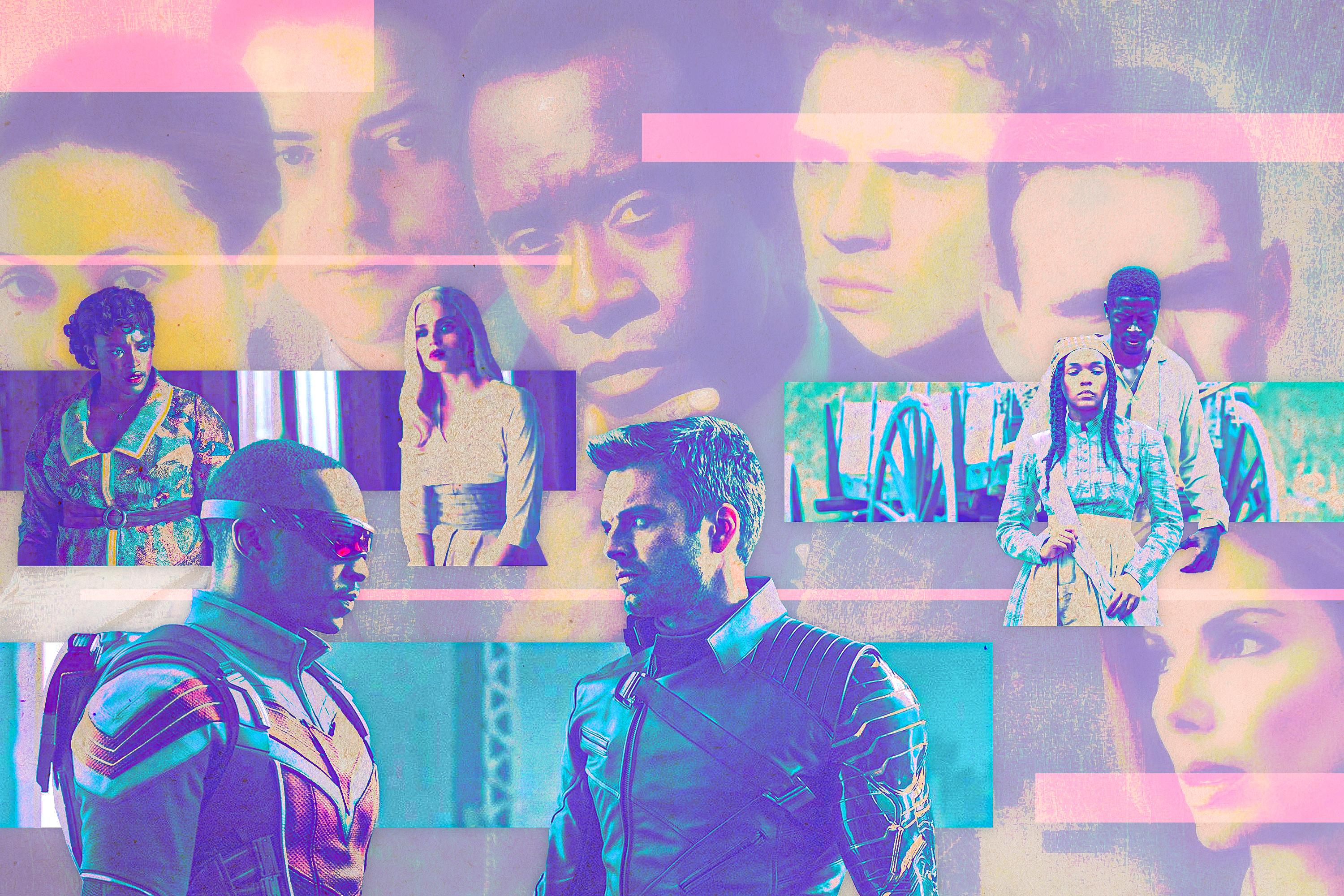
Last year, I watched Lovecraft Country, and by the eighth episode, I couldn’t stop thinking about Crash. A few weeks ago, I started watching The Falcon and the Winter Soldier, and the second episode got me thinking about ... Crash. Thirty minutes into Antebellum, I was thinking about Crash. Them? Crash. Slave Play? Crash. Boogie? Crash. Malcolm & Marie? I see Cameron and Christine from Crash.
There are modern race dramas, such as Get Out and Small Axe, which launch artful interrogations of racial dynamics; and then there are modern race dramas that, in their melodramatic excess, for the most part just remind me of Crash. Despite its dismal reputation these days, Crash may well be the most influential film in my various streaming queues.
Crash tracks more than a dozen characters, intertwined by racialized encounters with each other, for a rough 24 hours in Los Angeles. Crash pits whites, Blacks, Latinos, Asians, and Iranians in a dog-eat-dog struggle for validation. If only, Crash proposes, these people could slow down and perceive one another beyond the level of stereotype and resentment. Crash isn’t just a movie about race. It’s a movie about pluralism, distinguished—and, I’ll argue, overburdened—by its ensemble structure, designed to cram a wide variety of racial perspective into one potent fable. Director Paul Haggis says he set out to challenge the progressive hypocrisies in pluralist bastions such as Los Angeles. “It was a social experiment,” Haggis told The Huffington Post a few years ago. “I wanted to fuck with people.”
Released in May 2005, Crash cleaned up at the box office, earning nearly $100 million worldwide against a budget of just $6.5 million. It was also a relative critical success, particularly in the eyes of the Academy, which nominated the film for six Oscars, including Best Picture. Crash went on to win that award, in addition to Best Original Screenplay and Best Film Editing. Roger Ebert lauded the movie upon its release. “I don’t expect Crash to work any miracles,” Ebert wrote, “but I believe anyone seeing it is likely to be moved to have a little more sympathy for people not like themselves.” But a curious development happened over time: Crash encountered critical backlash. “I’ve never actively hated a movie as much as Crash,” Gene Demby wrote in one retrospective. “Its basic premise seems to be that personal animus is the well from which racism springs, and that absolution from racism can be found in being violently forced to relinquish one’s bitterness.” Ta-Nehisi Coates described the movie and its great acclaim as “the apotheosis of a kind of unthinking, incurious, nihilistic, multiculturalism.”
In the 16 years since the release of Crash, the U.S. has rushed through a series of milestones in race relations: a Black president, a new chapter in the civil rights movement, a white backlash, a U.S.-Mexico border wall, and now a national uptick in violence against Asian Americans. Hollywood has answered these shifts with new, hard-sought commitments to diversified casting and diversified stories. I never thought I’d live to see Warner Bros. distributing a star-studded movie about Fred Hampton. Now Crash stands—and decays—as a monument to a previous, naive phase. But more than any other movie about race, Crash has left a deep and abiding impression on big-budget entertainment with anti-racist convictions. With each passing year, Crash seems a bit more ridiculous in hindsight, and yet new dramas seem nonetheless determined to propagate the movie’s worst faults.
For its first 30 minutes or so, Crash introduces the many stereotypes that overpopulate the movie: the bigoted white police sergeant, John (Matt Dillon), and his naive junior partner, Tom (Ryan Phillippe); the Black carjackers, Anthony (Ludacris) and Peter (Larenz Tate); the fearful white socialite, Jean (Sandra Bullock); the light-skinned Black Hollywood couple, Cameron (Terrence Howard) and Christine (Thandiwe Newton); the tattooed Latino locksmith, Daniel (Michael Peña); and several others. Gradually, Crash subverts and reforms the stereotypes, the characters forced to confront each other in situations that put their prejudices to the test. Race is, by design, Haggis’s one and only idea about any of these characters. Crash betrays its heartfelt performances and some clever character drama with ridiculous contrivances to raise racial tension—the one and only motivation for anything—in every character arc. Take, for instance, Graham (Don Cheadle) and Ria (Jennifer Esposito), two police colleagues engaged in an affair. They’re having sex when Graham takes a phone call from his mother. Graham, a Black man, then cuts the call short by telling his mother, “I’m having sex with a white woman,” before hanging up. Ria, who is Puerto Rican and Salvadoran, objects to being described as a white woman. Graham then jokingly regards Ria as Mexican and wonders why Mexicans park their cars on their lawns.
In interviews, Haggis gets very defensive about this particular scene. He says he intended the race humor in the earlier parts of the movie to disarm the audience and sow misdirection about the movie’s dramatic bearings. It makes sense on a conceptual level. But what is this scene? Was there really no better way to introduce Graham’s mother while raising the racial tension in Graham and Ria’s relationship? Crash, at every turn, veers toward absurdity in order to illustrate bigotry—a substance that’s often a lot more variable and nuanced than the characters in this movie.
Cameron and Christine in particular resemble the couple in Malcolm & Marie, starring John David Washington and Zendaya. In the movie, Malcolm and Marie have an overwrought argument about racial condescension in film criticism, and they never seem to have a genuine romance so much as they have an ugly, running discourse. Malcolm and Marie’s clashes more or less resemble the moment when Cameron and Christine turn on each other, in a vindictive argument about assimilation, after John profiles Cameron and sexually assaults Christine at a traffic stop. That particular excess in Crash—John sexually assaulting Christine—gets me thinking about Antebellum, starring Janelle Monáe. Antebellum follows Black captives on a remote plantation run by violent white Confederate antebellum reenactors, including a man who repeatedly rapes Monáe’s character, Eden. This is all in service of some wildly overstated point about how much hasn’t changed in Black-white relations (since slavery).
Even the Marvel Cinematic Universe has gotten a bit busy and ridiculous in its characterization of racial strife. The Falcon and the Winter Soldier pairs Sam Wilson (Anthony Mackie) and Bucky Barnes (Sebastian Stan) in a buddy-dramedy struggle to succeed the retired Captain America. Naturally, Sam succeeding Captain America would stir some tension; Sam is Black, and Captain America, played by Chris Evans in the movies, isn’t just white. He is, or seems, prohibitively white. Here you have the basis for some decent race drama. But then The Falcon and the Winter Soldier lurches to tedious extremes. A bank denies Sam’s application for a home loan, a commentary on disparities and discrimination in lending. Sam and Bucky meet Isaiah Bradley, a disgruntled Black veteran of the Korean War, and his backstory turns out to be a commentary on the Tuskegee Study. Moments later, the police profile Sam as a potential criminal nuisance to Bucky. Taken individually these are sensible bits of racialized drama. But taken all together, and lacking any coherence or depth, they suggest there’s a cringeworthy shortcut being taken in a show that’s otherwise about a robot bird man and his grunge sidekick.
Among the many characters in Crash, Jean seems truest to Haggis’s mission “to bust liberals.” She’s also one of the more sensible characterizations in this largely senseless movie. She’s a wealthy, white woman who second-guesses her prejudices in the moment before the carjacking and then resents her hesitation after the fact. Jean sulks at home, ragging on her housekeeper, Maria, until the larger truth dawns on her in a dour phone conversation with a friend. “I am angry all the time,” Jean says, “and I don’t know why.” Otherwise, Crash employs a certain bluntness, verging on cartoonishness, in announcing each character’s prejudices despite the supposed sophistication of the more progressive characters, and often in wildly incongruous contexts. The very worst case is Tom. He spends the whole movie disgusted with John’s stereotyping before risking his life and career to make amends with Cameron, only to transform into a vengeful redneck blasting country music as soon as the hitchhiking Peter settles into his car in the final act. Who is this character and where did he come from all of a sudden? He seems born from Haggis’s inability to translate the variety of his cast into a variety of characterizations.
There’s one recent example that struck me as the most reprehensible fiction I’ve seen in a while. Lovecraft Country stages its eighth episode, “Jig-a-Bobo,” during the mourning for Emmett Till. The mourning brings two characters, the Black woman Ruby and the white woman Christina, into a bizarre, anachronistic confrontation about white fragility. It culminates with Christina hiring two men—no, I’m not making this up—to reenact Till’s murder on her. This isn’t a brave racial reckoning nor a subversive character drama. This is Crash.
I don’t even hate these things. The several episodes of Lovecraft Country before “Jig-a-Bobo” are great! But I fear a generation of storytellers who should know better—the sort of storytellers who would happily ridicule Crash—have learned all the wrong lessons from this ludicrous movie. Crash used bigotry as a shortcut. Whatever strong feelings you might have about the characters (as thin as they are) are for the most part due to their situation in a larger racial conflict. It’s certainly not due to the artful particulars of their character development. There’s only one great scene—well, apart from all the great scenes with Anthony and Peter together—in Crash. It’s a scene I mentioned earlier, and it’s the simplest scene in the movie: Jean at home alone, pacing her bedroom, venting on the phone to her friend, saying, “I am angry all the time, and I don’t know why.” It’s a modest, but poignant resolution for a character who can learn and grow only so much in a story spanning 24 hours. It’s a small truth with real insight into the nature of prejudice at the personal level. But no one remembers this scene. They remember the goofiest, melodramatic moments in Crash. They remember the cringe. And it shows.

